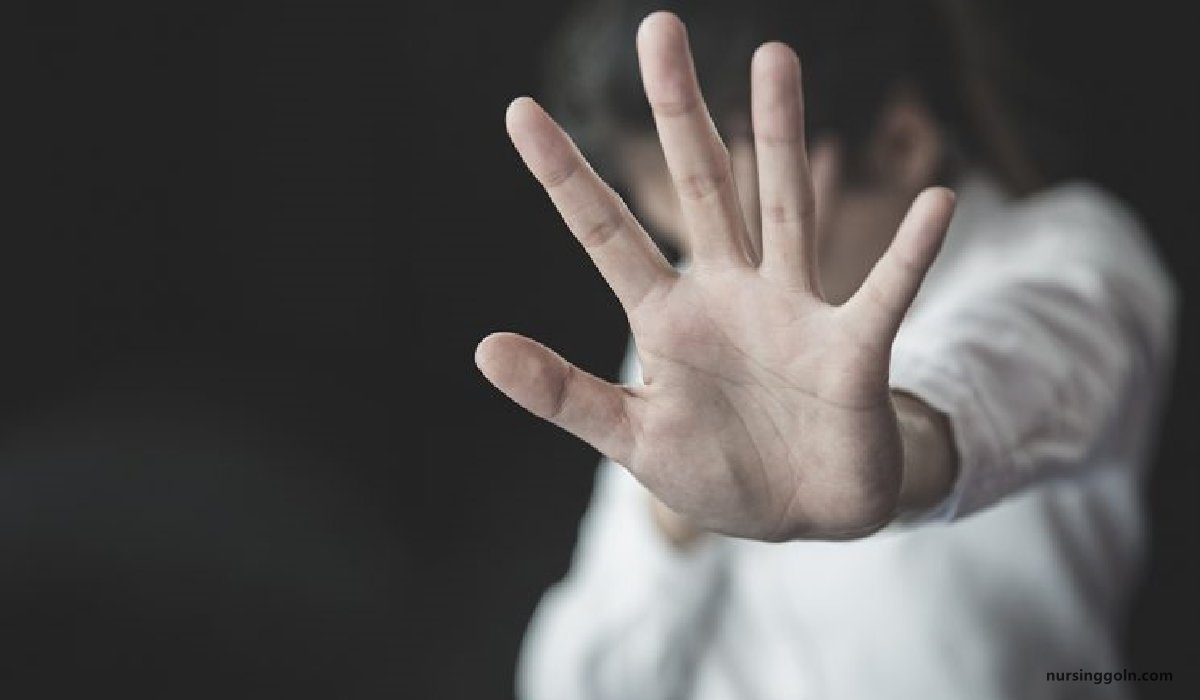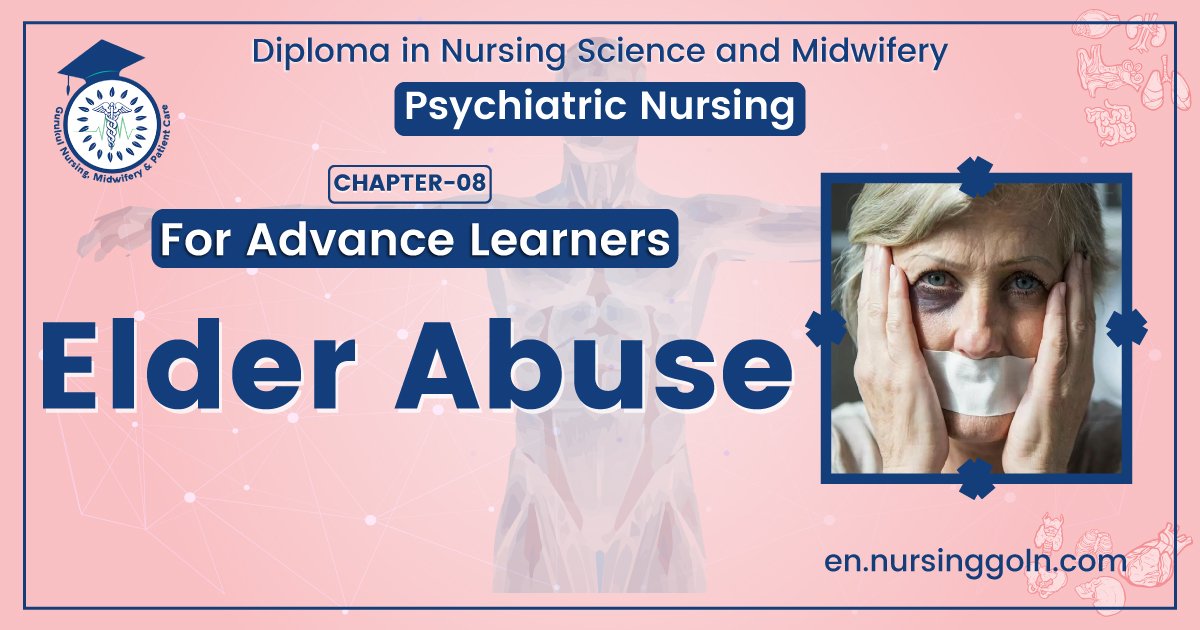Elder abuse – This book covers the entire syllabus of “Psychiatric Nursing” prescribed by the Universities of Bangladesh- for Basic and diploma nursing students. We tried to accommodate the latest information and topics. This book is an examination-friendly setup according to the teachers’ lectures and examination questions.
At the end of the book previous university questions are given. We hope in touch with the book students’ knowledge will be upgraded and flourish. The unique way of presentation may make your reading of the book a pleasurable experience.

Elder abuse
Definition of abuse:
Abuse is defined as “Willfully inflicting physical or mental pain. Unjustifiable confinement or deliberately withholding care to an elderly person.”
[Ref-Lesson Plan Vol-2,329]
Or,
Abuse is defined as any action that intentionally harms or injures another person. Abuse also encompasses inappropriate use of any substance, especially those that alter consciousness (e.g., alcohol, cocaine, methamphetamines)
Incidence of elder abuse:
Elder abuse takes several forms. The incidence of alder abuse appears to have risen within the past several years. This increase is thought to be due partially to the increase in the number of elderly people. Particularly the frail elderly. More attention has been given to the problem of elder abuse than in past years. The stresses of caring for older parent’s falls all fewer children than in past generation, and these children are busy with their own lives and personal stress.
[Ref-Lesson Plan Vol-2,329]
Define elder abuse
Elder abuse (also called “elder mistreatment,” “senior abuse,” “abuse in later life,” “abuse of older adults,” “abuse of older women,” and “abuse of older men”) is “a single, or repeated act, or lack of appropriate action, occurring within any relationship where there is an expectation of trust, which causes harm or distress to an older person.”
[Ref-www.wikipedia.com/]
Or,
Elder abuse is a general term used to describe harmful acts toward an elderly adult, such as oral physical abuse, sexualabuse, emotional or psychological abuse, financial exploitation, and neglect , including self-neglect.
Some common risk factors for elder abuse include:
➤ Isolation
➤ Substance Abuse
➤ Violence
➤ Declining Physical and/or Cognitive Health
➤ Dependence and Shared Living Arrangements
➤ Stress
➤ Memory problems
➤ Depression
➤ Loneliness
➤ Alcohol abuse
➤ Criminal history
➤ Unemployment
➤ Feeling of resentful
➤ Dependence
➤ Family conflict or dysfunction
Types of elder abuse:
1. Self-neglect: neglecting to care for self, most often because of depression, dementia or lack of resources.
2. Passive neglect: caregiver not providing adequate care because of lack of knowledge, skills, or physical ability.
3. Active neglect: deliberately not caring for an elderly person.
4. Financial abuse: Unauthorized use of money or property of an elderly person.
5. Physical abuse: inflicting physical pain or injury.
6. Psychological abuse: emotional or mental abuse including belittling, ridiculing, name calling, isolation and saying things to frighten an older adult.
7. Sexual abuse: abuse of sexual nature including sexual harassment, sexual coercion or sexual assault.
8. Fraud: misuse of elder persons check, credit cards or account.
[Ref-Vol-2,329& lecture]
Level of elder abuse:
1. Individual level abuse
2. Family level abuse
3. Community level abuse
4. Society level abuse
5. State level abuse
6. Abuse in media
Signs of elderly abuse:
1. Emotional (or psychological) abuse: Signs of emotional (or psychological) abuse include:
➤ Fear
➤ Depression or low mood
➤ Confusion
➤ Loneliness
➤ Feeling of helplessness
2. Neglect:
Signs of neglect include:
➤ An older person who is hungry, thirsty or has lost a lot of weight.
➤ An older person who is wearing the wrong clothing for the weather conditions.
➤ An older person who is living in an environment that is dirty or unsafe.
➤ An older person whose health problems have worsened due to their medications being mismanaged.
➤ An older person with unexplained conditions such as hypothermia, dehydration or pressure sores.
3. Financial abuse:
Signs of financial abuse include:
➤ Missing belongings.
➤ Inability to find the money for basics such as food, clothing, transport costs and bills.
➤ Large withdrawals or big changes in banking habits or activities.
➤ Property transfers when the person is no longer able to manage their own financial affairs.
➤ Fear, stress and anxiety.
4. Physical abuse:
Signs of physical abuse include:
➤ Pain or restricted movement.
➤ Bruises, bite marks, cuts, burns, scratches.
➤ Unexplained accidents.
➤ Unexplained injuries such as broken bones, sprains, punctures.
➤ Over or under-use of sedation.
➤ Fear or anxiety.
➤ Stories about injuries that conflict between the older person and others.
5. Social abuse:
Signs of social abuse include:
➤ Sadness or grief at loss of contact with others.
➤ Withdrawal or listlessness.
➤ Loss of self-esteem.
6. Sexual abuse:
Signs of sexual abuse include:
➤ Unexplained sexually transmitted disease.
➤ Recent incontinence (bladder or bowel).
➤ Internal injuries.
➤ Bruises, bite marks, pain, burn marks.
➤ Trauma including bleeding around genitals, chest, rectum or mouth.
➤ Torn or bloody underclothing or bedding.
➤ Anxiety when near, or contact suggested with the abuser

Health effect of elder abuse
Consequences of Elder Abuse:
The possible physical and psychosocial consequences of elder abuse are numerous and varied.
1. Physical Effects
The most immediate probable physical effects include the following:
➤ Welts, wounds, and injuries (e.g., bruises, lacerations, dental problems, head injuries, broken bones, pressure sores).
➤ Persistent physical pain and soreness.
➤ Nutrition and hydration issues.
➤ Sleep disturbances.
➤ Increased susceptibility to new illnesses (including sexually transmitted diseases).
➤ Exacerbation of preexisting health conditions.
➤ Increased risks for premature death.
2. Psychological Effects
Established psychological effects of elder abuse include high levels of distress and depression. Other potential psychological consequences that need further scientific study are
➤ Increased risks for developing fear and anxiety reactions.
➤ Learned helplessness.
➤ Post-traumatic stress disorder.
Spectrum of elder abuse:
1. Physical elder abuse: Physical elder abuse is the non-accidental use of force against an elderly person that results in physical pain, injury, or impairment. Such abuse includes not only physical assaults such as hitting or shoving but the inappropriate use of drugs, restraints, or confinement.
Signs:
➤ Unexplained signs of injury, such as bruises, welts, or scars, especially if they appear symmetrically on two sides of the body.
➤ Broken bones, sprains, or dislocations.
➤ Report of drug overdose or apparent failure to take medication regularly (a prescription has more remaining than it should).
➤ Broken eyeglasses or frames.
➤ Signs of being restrained, such as rope marks on wrists.
➤ Caregiver’s refusal to allow to see the elder alone.
2. Emotional or psychological abuse: In emotional or psychological abuse, people speak to or treat elderly persons in ways that cause emotional pain or distress.
Signs:
➤ Intimidation through yelling or threats,
➤ Humiliation and ridicule.
➤ Habitual blaming or scapegoating.
➤Ignoring the elderly person.
➤ Treating the elderly like a child.
➤ Isolating an elder from friends or activities.
➤ Terrorizing or menacing the elderly person
3. Sexual elder abuse: Sexual elder abuse is contact with an elderly person without the elder’s consent. Such contact can involve physical sex acts, but activities such as showing an elderly person pornographic material, forcing the person to watch sex acts, or forcing the elder to undress are also considered sexual elder abuse.
Signs
➤ Bruises around breasts or genitals.
➤ Unexplained vaginal or anal bleeding.
➤ Torn, stained, or bloody underclothing.
4. Financial abuse: This involves unauthorized use of an elderly person’s funds or property, either by a caregiver or an outside scam artist.
Signs:
➤ Misuse an elder’s personal checks, credit cards, or accounts.
➤ Steal cash, income checks, or household goods.
➤ Forge the elder’s signature.
➤ Engage in identity theft.
5. Elder neglect: Elder neglect-failure to fulfill a caretaking obligation-constitutes more than half of all reported cases of elder abuse. It can be intentional or unintentional, based on factors such as ignorance or denial that an elderly charge needs as much care as he or she does.
Signs
➤ Duplicate billings for the same medical service or device. ami
➤ Evidence of overmedication or under medication.
➤ Evidence of inadequate care when bills are paid in full.
➤ Problems with the care facility: poorly trained, poorly paid, or insufficient staff; crowding; inadequate responses to questions about care.
[Ref-Lecture of TTMNCI]

Below are a few examples of prevention of elder abuse:
1. Primary – Prevention Efforts:
A. Education on detecting abuse for lay and professional audiences, including targetingung older adults.
B. Professional “gatekeepers” (e.g., pharmacists, physicians, clergy, hospital discharge A planners, legal aid attorneys). Using e-learning technology to widely disseminate educational curriculum.
C. Programs to identify and support caregivers who are at “high risk” of abusing.
D. Registries of those who have been convicted of elder abuse (similar to sex offender registries).
E. Caregiver support programs.
F. Programs that assist elders to plan ahead for incapacity (e.g., legal and financial tools).
G. Public awareness campaigns.
H. Research on prevention strategies, risk and protective factors, cultural factors.
I. Passing laws that require screening of clients at intake or at some regular interval.
2. Secondary – Intervention Efforts:
A. Emergency shelter for victims.
B. Medical and psychological evaluations in home.
C. Counseling for victims (group or individual).
D. Transportation assistance to court, etc.
E. Legal services for restraining orders, etc.
F. Home security repairs.
3. Tertiary – Response Efforts:
A. Justice system efforts, including:
➤Elder Abuse Court or Elder Court programs.
➤Elder abuse vertical prosecution units.
➤ Elder abuse victim services units.
B. Multi-disciplinary approaches to elder abuse cases:
➤ Establishment of multi-disciplinary teams for case consultation.
➤ Financial abuse specialist teams (FAST).
➤ Elder Abuse Forensic Centers.
➤ Elder Death/Fatality Review Teams.
C. Services to victims to reduce re-victimization:
➤ Housing
➤ Counseling
➤ Home care
➤ Legal services
In all of these areas, we need research to help identify evidence-based practices that can be brought to scale to strengthen states’ and the nation’s work to eliminate elder abuse. We also need to engage leaders in related fields to build collaborations in elder abuse research and training. These efforts would help our field identify the most feasible and crucial areas to allocate resources to address the existing gaps in our systems of elder abuse detection, intervention and prevention.
Manage an elder abuse in the community:
➤ Identify the possible causes and risk factors.
➤ Assessment of signs and symptoms of elder abuse.
➤ Identify the actual problems related to abuse,
➤ Assessment of general quality of health.
➤ Emergency shelter for victims
➤ Medical and psychological evaluations in home
➤ Counseling for victims (group or individual)
➤ Transportation assistance to court, etc.
➤ Legal services for restraining orders, etc.
➤ Home security repairs.
➤ Proper community education.
➤ Improve consciousness among the community.
[Ref by Lecture INCI]
Read more:
